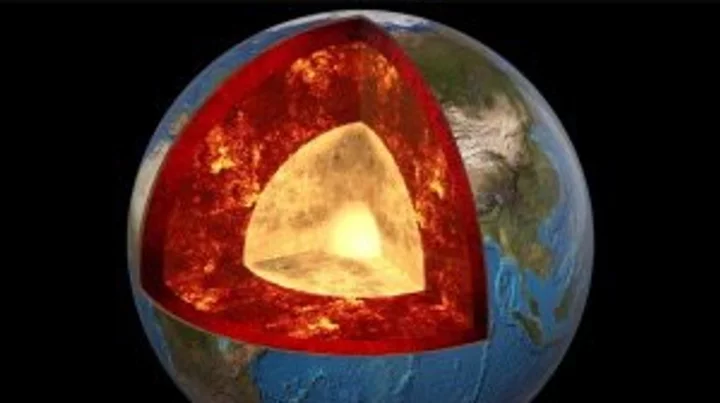
Copy of Science news - live: 'Alien corpses' unveiled to Mexican Congress
It feels like this year, more than any other, we’re seeing a stream of science stories that continue to blow our minds. Every day is a school day online in 2023, and a host of studies, research papers and headline-making breakthroughs have completely changed our understanding of the world around us at every turn. There have been missions to the moon and findings about our planet which could turn everything we thought we knew on its head – not to mention baffling hearings on UFOs taking place in the US congress. These are the biggest science stories so far this year that have caught our attention in a big way. https://www.indy100.com/science-tech/ocean-beneath-earth-crust-ringwoodite-2665333030 Test Test Scientists discover continent that had been missing for 375 years Geoscientists discovered a continent that had been hiding in plain sight for almost 375 years. Historically, there's been speculation about whether a continent known as Zealandia or Te Riu-a-Māui in the Māori language exists. Read more here. 'Alien corpses' unveiled in Mexico divide conspiracy theorists Christmas has come early for UFO watchers, with the alleged corpses of real-life aliens displayed for the world to see. The startling revelation came during a congress hearing in Mexico City on Tuesday, titled the Public Assembly for the Regulation of Unidentified Anomalous Aerial Phenomena (UAP). During the session, which was streamed online, Mexican ufologist Jaime Maussan presented what he claimed were two perfectly preserved “non-human entities”. Read more here. Buy now , Massive ocean discovered beneath the Earth's crust containing more water than on the surface People are only just realising that there’s a massive ocean hidden under the Earth’s crust. It turns out there’s a huge supply of water 400 miles underground stored in rock known as 'ringwoodite'. Scientists previously discovered that water is stored inside mantle rock in a sponge-like state, which isn’t a liquid, solid or a gas, but instead a fourth state. Read more here. Buy now , Sign up for our free Indy100 weekly newsletter Have your say in our news democracy. Click the upvote icon at the top of the page to help raise this article through the indy100 rankings
2023-09-14 19:46

Study discovers vast numbers of women experience mental health issues because of period pain
A study has shown that millions of women and girls experience debilitating periods, that even cause mental health problems. A survey of 3,000 women and girls in the UK aged 16 to 40 for the Wellbeing of Women charity found that 86 per cent had had mental health problems, such as depression, anxiety and mood changes, in relation to their period, Meanwhile, of those surveyed, 96 per cent had experienced period pain, with 59 per cent saying their pain was severe. 91 per cent had experienced heavy periods, with 49 per cent saying their bleeding was severe. Even though these are common symptoms in women and girls with gynaecological conditions such as endometriosis, adenomyosis, fibroids and polycystic ovary syndrome, the report found that 51 per cent of respondents felt their healthcare professional had failed to take their problems seriously, and 82 per cent said they needed better access to accurate information on period problems. A further one-third never seek medical help, and more than half say their symptoms are not taken seriously, despite other symptoms including pain, heavy bleeding and irregular cycles. Prof Dame Lesley Regan, the chair of Wellbeing of Women, said: “It’s simply unacceptable that anyone is expected to suffer with period symptoms that disrupt their lives, including taking time off school, work, or their caring responsibilities, all of which may result in avoidable mental health problems. “Periods should not affect women’s lives in this way. If they do, it can be a sign of a gynaecological condition that requires attention and ongoing support – not dismissal.” Wellbeing of Women has launched its “Just a Period” campaign, which Regan said aims to address “the many years of medical bias, neglect and stigma in women’s health”. This includes tips on how to get the most out of seeing your GP and what women should do if they feel they have been dismissed by health professionals. Responding to the findings, Dr Ranee Thakar, the president of the Royal College of Obstetricians and Gynaecologists, said: “All too often women are living with debilitating symptoms, waiting to receive support or treatment for far longer than they should. “Access to high-quality information and support about periods, gynaecological conditions and their symptoms is vital to ensuring that women and girls get the help that they need at the right time.” Caroline Nokes, the Conservative MP and chair of the women and equalities committee, which is conducting an inquiry into reproductive and gynaecological health, said: “There is a terrible phrase: ‘Well, it’s just a period, why are you making a fuss about that? Can’t you just get on with it?’ Yet many women and girls are experiencing horrendous period symptoms and gynaecological conditions. Endometriosis alone affects 1.5 million women in the UK and costs the economy £8.2bn. Now is the time for change.” Anneliese Dodds, the shadow secretary of state for women and equalities, said: “Over the past few years, we have opened up the conversation around the menopause, and now we need to see this change with periods as well.” Sign up to our free Indy100 weekly newsletter Have your say in our news democracy. Click the upvote icon at the top of the page to help raise this article through the indy100 rankings.
2023-09-14 17:56

UFO hearings - live: Nasa to reveal first ever report on mysterious objects in sky
Nasa is about to release the first findings from its report into unidentified anomalous phenomena, or UFOs. The space agency has commissioned a study in response to a variety of reports of what appear to be unexplained and unknown craft, reported by US pilots and others. It says that unidentified anomalous phenomena, or UAP, are defined as “observations of events in the sky that cannot be identified as aircraft or known natural phenomena from a scientific perspective”. It has noted that there are very few high-quality observations of the phenomena, which makes them difficult to understand scientifically. The first report will “inform NASA on what possible data could be collected in the future to shed light on the nature and origin of UAP”, it said in its announcement. “The report is not a review or assessment of previous unidentifiable observations.” The media briefing on the report will begin at 10am local eastern time, or 3pm in the UK. The report will be published about half an hour before, Nasa said.
2023-09-14 17:18

Elon Musk was on brink of death after catching malaria on South African safari, book claims
Elon Musk contracted malaria while on safari in South Africa in 2000 and almost died, a new biography has claimed. Walter Isaacson detailed the billionaire’s near-death experience in a new biography published this week. Mr Musk contracted malaria during a holiday in South Africa after being ousted as CEO of PayPal by Peter Thiel in October 2000. It was Mr Musk’s first time back in his native South Africa since leaving for Canada aged 17, Mr Isaacson wrote. During his trip, Mr Musk and his then-wife Justine Musk went to a game reserve. When he returned to California in January 2001, Mr Musk reportedly began to feel dizzy and experienced recurring waves of chills and started throwing up in an emergency room, leading to him being wrongly diagnosed with viral meningitis. The billionaire’s condition worsened until his “pulse was barely perceptible,” according to the book. Mr Musk was only diagnosed with malaria after a doctor with expertise in infectious diseases passed by his bed at Sequoia Hospital in Redwood City and realized he had a potentially fatal form of the disease that can affect the central nervous system or cause “acute respiratory distress,” according to the Centers for Disease Control and Prevention. Mr Isaacson described how it took Mr Musk five months to fully recover after he was put in intensive care for 10 days and treated with doxycycline and chloroquine. An email written by the head of human resources at X.com — later Paypal — to Mr Musk’s former business partners Peter Thiel and Max Levchin described how he was “actually only hours from death,” the biography revealed. The Tesla CEO’s mother Maye Musk described the ordeal as “terrifying”. “I remember your malaria infection very clearly. You were unconscious, yellow and shivering for days. Tubes were going in and out of you. It was a terrifying time. Modern medicine saved you,” she wrote on X, formerly known as Twitter. While he was in hospital, Mr Musk’s then-colleagues found he’d taken out a life insurance policy worth $100 million on behalf of X.com. “If he had died, all of our financial problems were going to be solved,” Mr Thiel reportedly told Isaacson. Mr Musk told Isaacson: “Vacations will kill you. Also, South Africa – that place is still trying to destroy me.” The tech mogul co-founded online bank X.com in 1999. The company merged with another payment system, Confinity, which was co-founded by Thiel and Levchin, and was renamed PayPal. Isaacson was given access to the Tesla and SpaceX CEO over the past two years, which culminated in Mr Musk’s biography being published this week. The writer spoke with several figures close to Mr Musk while writing the biography, including his ex-girlfriend Grimes and his former wives Tallulah Riley and Justine Musk, as well as his estranged father. So far, the book has also claimed Musk and Grimes secretly welcomed a third child, in addition to X and their 22-month-old daughter Exa Dark Sideræl. However, it was not immediately clear when their second son, named Techno Mechanicus or “Tau”, was born. In the biography, Isaacson also writes that the tech mogul’s brother Kimbal Musk and his friends “hated” ex-girlfriend and actor Amber Heard so intensely, it “made their distaste for Justine [Musk’s first wife] pale”. One review by The New York Times said Isaacson’s biography stitches together a portrait of a Mr Musk as a “mercurial ‘man-child’”. Read More Grimes says Elon Musk was ‘clueless’ about why she was upset by C-section photo Elon Musk ‘hardly remembers’ his own ‘demon-like’ episodes, biographer claims Book Review: 'Elon Musk' offers a revealing but not surprising portrait of tech mogul Elon Musk makes prediction for imminent Starship launch Twitter rival Bluesky hits new milestone Putin praises Musk days after report Tesla boss stopped Ukrainian attack
2023-09-14 01:18

'Earthquake lights' video seen moments before Morocco tragedy fuel age-old theory
With the tragedy and horror wreaked in Morocco last week, it's unsurprising that people’s focus hasn’t been on the skies. And yet, Friday’s devastating earthquake, has also sparked renewed interest in a mysterious aerial phenomenon. Footage shared to social media just moments before the 6.8-magnitude tremor struck the High Atlas mountains appears to show blinding lights flashing across the sky. Experts have suggested that the jaw-dropping sight is evidence of an enigmatic natural occurrence called “earthquake lights”. Reports of these bright flashes go back centuries. And yet, very little is known about them, to the point that scientists aren’t even sure they’re real. Indeed, some experts have concluded that there isn’t sufficient proof to support their existence, the United States Geological Survey notes. Nevertheless, “people have wondered about them forever," Karen Daniels, a physicist at North Carolina State University, told the New York Times. "It's one of those persistent mysteries that hang around and never quite get nailed." The issue with studying earthquake lights is that since earthquakes are impossible to predict, so are any preceding celestial pyrotechnics. Not knowing when or where they will occur means researchers can’t preemptively install the necessary equipment needed to detect them. Essentially, the only evidence we have comes from eyewitness accounts and, more recently, video recordings. And there is an abundance of the former, with a 2014 study noting that aerial luminous phenomena were reported in relation to 65 earthquakes which occurred in Europe and America over a period of 200 years. These descriptions of earthquake lights vary in their details, with some recalling on-and-of lightning-style flashes, and others minutes-long glows of different colours. “All of these have been reported by observers,” John Ebel, a seismologist at Boston Collegel told the NYT. “Which ones are actually true, and which ones are products of their imagination, we can’t really say.” One theory behind the formation of earthquake lights is that they are the result of friction between tectonic plates generating electricity. However, most experts are unconvinced by this hypothesis, including Dr Daniels. She told the NYT: “Rock on rock is not a situation where people have been able to generate large charge separation. And so it just doesn’t seem like a very good explanation for what people see.” Other scientists have suggested electrical arcing from power lines shaken by earthquakes could be responsible for the sky flares. But Dr Daniels acknowledged it’s still possible that there’s no link at all between the lights and tectonic events. “We’re comforted by things that we can understand, and we’re scared by things we don’t,” she pointed out. “I think that’s part of the reason we’re so fascinated by this phenomenon.” Sign up for our free Indy100 weekly newsletter Have your say in our news democracy. Click the upvote icon at the top of the page to help raise this article through the indy100 rankings.
2023-09-13 21:59

Science news - live: Hidden oceans and moon structures discovered
It feels like this year, more than any other, we’re seeing a stream of science stories that continue to blow our minds. Every day is a school day online in 2023, and a host of studies, research papers and headline-making breakthroughs have completely changed our understanding of the world around us at every turn. There have been missions to the moon and findings about our planet which could turn everything we thought we knew on its head – not to mention baffling hearings on UFOs taking place in the US congress. These are the biggest science stories so far this year that have caught our attention in a big way. 'Alien corpses' unveiled in Mexico divide conspiracy theorists Christmas has come early for UFO watchers, with the alleged corpses of real-life aliens displayed for the world to see. The startling revelation came during a congress hearing in Mexico City on Tuesday, titled the Public Assembly for the Regulation of Unidentified Anomalous Aerial Phenomena (UAP). During the session, which was streamed online, Mexican ufologist Jaime Maussan presented what he claimed were two perfectly preserved “non-human entities”. Read more here. Buy now , Massive ocean discovered beneath the Earth's crust containing more water than on the surface People are only just realising that there’s a massive ocean hidden under the Earth’s crust. It turns out there’s a huge supply of water 400 miles underground stored in rock known as 'ringwoodite'. Scientists previously discovered that water is stored inside mantle rock in a sponge-like state, which isn’t a liquid, solid or a gas, but instead a fourth state. Read more here. Buy now , Sign up for our free Indy100 weekly newsletter Have your say in our news democracy. Click the upvote icon at the top of the page to help raise this article through the indy100 rankings
2023-09-13 19:25

Apple banned from selling iPhone 12 in France due to ‘too high radiation’
Apple has been forced to halt sales of its iPhone 12 in France after a watchdog claimed the device emits too much radiation. The smartphone, which was first released in 2020, has a Specific Absorption Rate (SAR) that is above the legal limit, according to France’s National Frequency Agency (ANFR), which oversees radio-electric frequencies as well as public exposure to electromagnetic radiation. The agency tested 141 phones and found that the iPhone 12 was more than 40 per cent above the legal limit for SAR. The ANFR called on Apple in a statement on Tuesday to “implement all available means to rapidly fix this malfunction.” Corrective updates to the iPhone 12 will be monitored by the agency, according to the statement. If they don’t work, “Apple will have to recall” phones that were already sold, it said. The agency consistently tests devices for waves capable of being absorbed by the human body, measuring against the European Union standard of 4 watts per kilogram. The ANFR said the iPhone 12 met the required threshold when radiation levels were assessed for a phone kept in a jacket or in a bag. The Independent has reached out to Apple for comment. Jean-Noel Barrot, France’s junior minister for digital economy, told Le Parisien newspaper on Tuesday that the ANFR’s data would be shared with other EU member states, which he warned could have a “snowball effect” on Apple. “Apple is expected to respond within two weeks,” he said. “If they fail to do so, I am prepared to order a recall of all iPhones 12 in circulation. The rule is the same for everyone, including the digital giants.” The ANFR’s announcement came on the launch day of Apple’s latest iPhone 15, which saw the whole 12 series of iPhones discontinued. This means any ban is unlikely to have a significant impact on Apple’s phone sales, however a recall could prove damaging depending on the scale. Additional reporting by agencies Read More All the key announcements from Apple’s iPhone 15 event Why Apple getting rid of lightning cable iPhone charger is a big deal Here’s the brand new Apple Watch Apple to stop using leather in all new products
2023-09-13 18:29

Why Do Truck Drivers Say “10-4”?
“10-4” isn’t any quicker than saying “OK.” But it is a storied trucker tradition.
2023-09-13 03:27

iPhone 15 Pro: Apple reveals premium phone with brand new material and features
Apple has unveiled the new iPhone 15 Pro, with an entirely new material. The new device will be made out of titanium, and rely on a host of new manufacturing processes. Its new material and design allows it to be the lightest Pro phone Apple has made, and includes the thinnest edges around the display. As well as the titanium, the new phone has the toughest glass-based material in the industry and an aluminium structure inside the phone, with the two materials joined in a new way that should make the phone extra strong, Apple said. The glass is now much easier to replace, Apple said. :: Follow our coverage of the Apple event here. It comes in two sizes, 6.1-inches and 6.7-inches. And it comes in four new colours: black, white, blue and a natural titanium. The titanium itself is a “grade five” alloy, Apple said, the same material used on the Mars rover. The new material also brings a new look, with a brushed texture on the side of the phone. As well as the new material, the iPhone 15 Pro brings a new customisable “action button” on the side of the phone, and an improved “A17 Pro” chip inside it. The action button replaces the mute switch on the side of the phone, and does the same job by default. But it can be changed to start voice memos, open the camera – or to start complex processes, by using Apple’s Shortcuts app. The new chip has “next-level performance”, Apple said, with improvements including dramatically improved graphics performance. Apple claimed the device is a “new chapter in iPhone performance”, and it focused particularly on the gaming performance that the new chip will allow. The iPhone 15 Pro has “the equivalent of seven camera lenses”, Apple said, even though it retains the three visible lenses on the back of the phone. That is partly because the iPhone 15 Pro Max has a 5x optical zoom, by using the extra space in the bigger device as well as a “tetra prism” design that bounces light around in the phone. The new camera also has a new coating to reduce lens flare, and better performance in low light. Like the normal iPhone 15, it has a 48 megapixel camera but offers the option to merge that down into a 24 megapixel image, which Apple said should allow for better quality and high resolution images. Like its cheaper iPhone 15 sibling, the 15 Pro will also be the first phone to switch to a USB-C charging port to charge. In the Pro model, that allows for USB 3 speeds, Apple said. Read More Apple is changing the plug on the bottom of your iPhone Here is the iPhone 15 Apple to stop using leather in all new products
2023-09-13 02:20

Scientists discover new Black holes that could be creeping up on Earth
A new study has revealed that black holes could be lurking much closer to Earth than anticipated. A black hole in space is when "gravity pulls so much that even light can not get out," NASA explains. "The gravity is so strong because matter has been squeezed into a tiny space. This can happen when a star is dying." Due to no light being present, they are invisible. Only special tools can pick up on them. There are said to be around 10 million to 1 billion mass black holes in the Milky Way, according to Science Alert. However, astrologers only know of about 20 of them. Now, a recent study has revealed that they could be a lot closer to Earth than previously thought after investigating the Hyades cluster, "a group of stars located 150 light-years away". In a statement, astrophysicist Stefano Torniamenti of the University of Padua explained: "Our simulations can only simultaneously match the mass and size of the Hyades if some black holes are present at the centre of the cluster today (or until recently). The Hyades with hundreds of stars is said to be approximately 625 million years old. Due to its packed environment, "higher rates of collisions and mergers" are expected. At 153 light-years away, it is considered the closest star cluster to Earth. Researchers were able to observe two or three black holes in the Hyades, which are either still present or ejected less than 150 million years ago and hovering around the outskirts. "This observation helps us understand how the presence of black holes affects the evolution of star clusters and how star clusters in turn contribute to gravitational wave sources," Professor Mark Gieles of the University of Barcelona said. Sign up for our free Indy100 weekly newsletter Have your say in our news democracy. Click the upvote icon at the top of the page to help raise this article through the indy100 rankings.
2023-09-12 22:56

Scientists discover huge exoplanet 120 light years from Earth that ‘could contain signs of life’
An exoplanet more than eight times the size of Earth and potentially habitable has been discovered by scientists. Exoplanet K2-18 b was detected by NASA’s James Webb Space Telescope and piqued scientists’ interest after data suggested it may be covered in an ocean and have a hydrogen-rich atmosphere that could support life. Scientists are also encouraged by a hint of the detection of the molecule dimethyl sulphide (DMS). On Earth, DMS is only produced by microbial life, but the team has yet to confirm the detection and search for evidence of biological activity. The groundbreaking discovery of K2-18 b may see the exoplanet come under the unique classification of a “Hycean” planet – ones which are candidates for life thanks to their hydrogen-rich atmospheres and water cover. The amount of methane and carbon dioxide combined with the shortage of ammonia suggests there may be a water ocean underneath a hydrogen-rich atmosphere in K2-18 b. K2-18 b lies within the constellation of Leo and orbits a dwarf star called K2-18. It lies around 120 light years away from Earth and is within the habitable zone. However, scientists added that this does not necessarily mean it can support life. Nikku Madhusudhan, an astronomer at the University of Cambridge and lead author of the paper, explained: “Our findings underscore the importance of considering diverse habitable environments in the search for life elsewhere. “Traditionally, the search for life on exoplanets has focused primarily on smaller rocky planets, but the larger Hycean worlds are significantly more conducive to atmospheric observations.” Sign up to our free Indy100 weekly newsletter Have your say in our news democracy. Click the upvote icon at the top of the page to help raise this article through the indy100 rankings.
2023-09-12 17:22

New invention could herald ‘battery revolution’, scientists say
Researchers have invented a new battery that they claim could have profound implications for the future of energy storage and renewable technologies. The lithium-based redox-flow battery, developed by a team at the University of Cincinnati, could prove crucial for wind and solar operations, where large-scale batteries are needed to store energy during times of overproduction and release it when production drops off. “Energy generation and energy consumption is always mismatched,” said Jimmy Jiang, who led the research at the University of Cincinnati. “That’s why it’s important to have a device that can store that energy temporarily and release it when it’s needed.” The novel design removes the membrane that separates the positive and negative sides of the battery, which is one of the most expensive parts of this type of battery and has previously hindered development. The membrane-free battery exhibited high voltage and energy density that could potentially meet the demands of large-scale green energy operations at an economically viable cost for the first time. “This design significantly decreases material costs,” said Soumalya Sinha, a visiting professor at the University of Cincinnati who was involved in the research. “We’re trying to achieve the same performance at a cheaper cost.” The team has submitted patent applications for the design, which Dr Jiang said will herald a “battery revolution” within the next 20 years. “I am confident about that,” he said. “There is a lot of intense research going into pushing the boundaries of battery performance.” The research was detailed in a paper, titled ‘Development of high-voltage and high-energy membrane-free nonaqueous lithium-based organic redox flow batteries’, published in the journal Nature Communications. Read More Volcano discovery could power electric cars for decades, scientists say
2023-09-12 03:57
